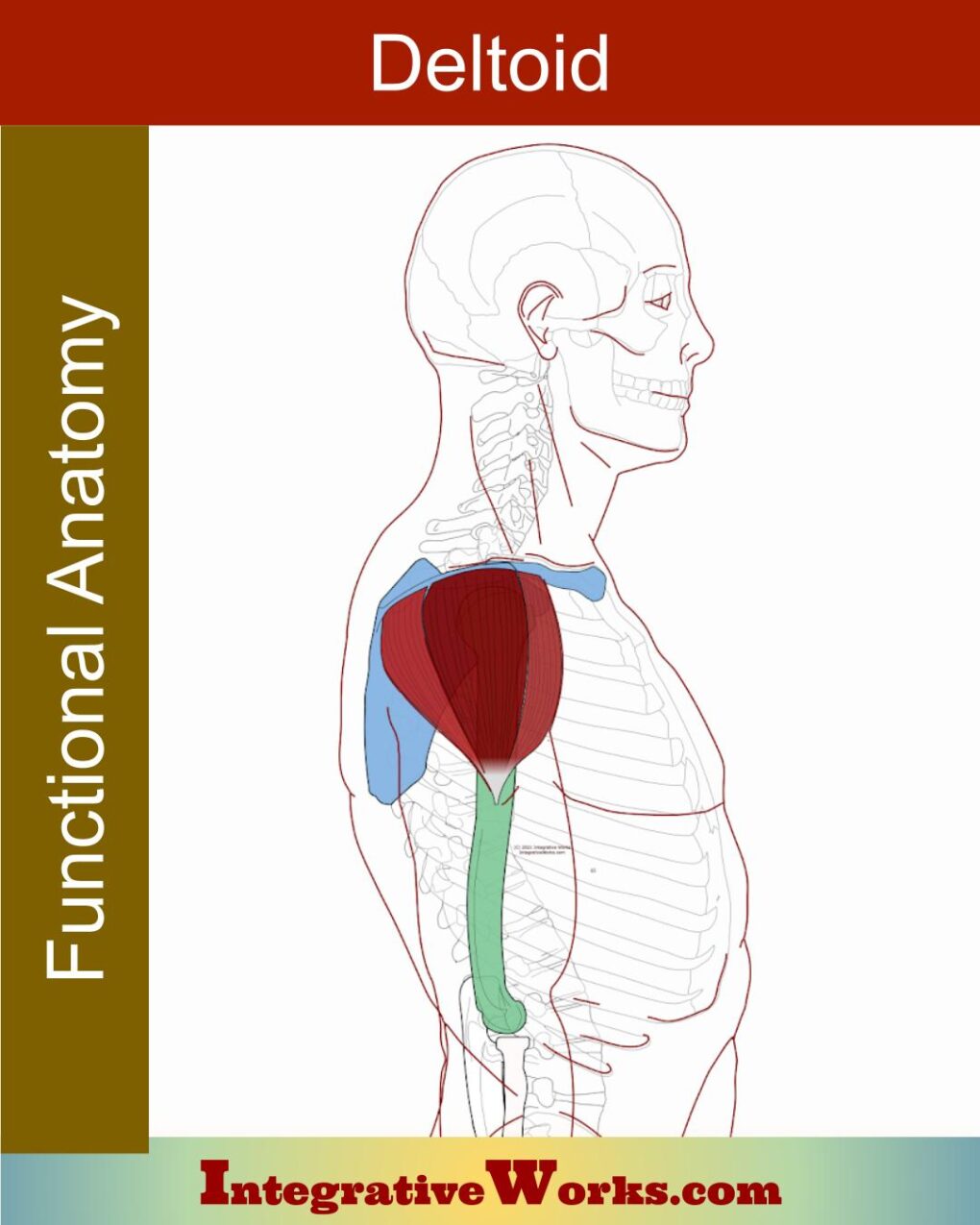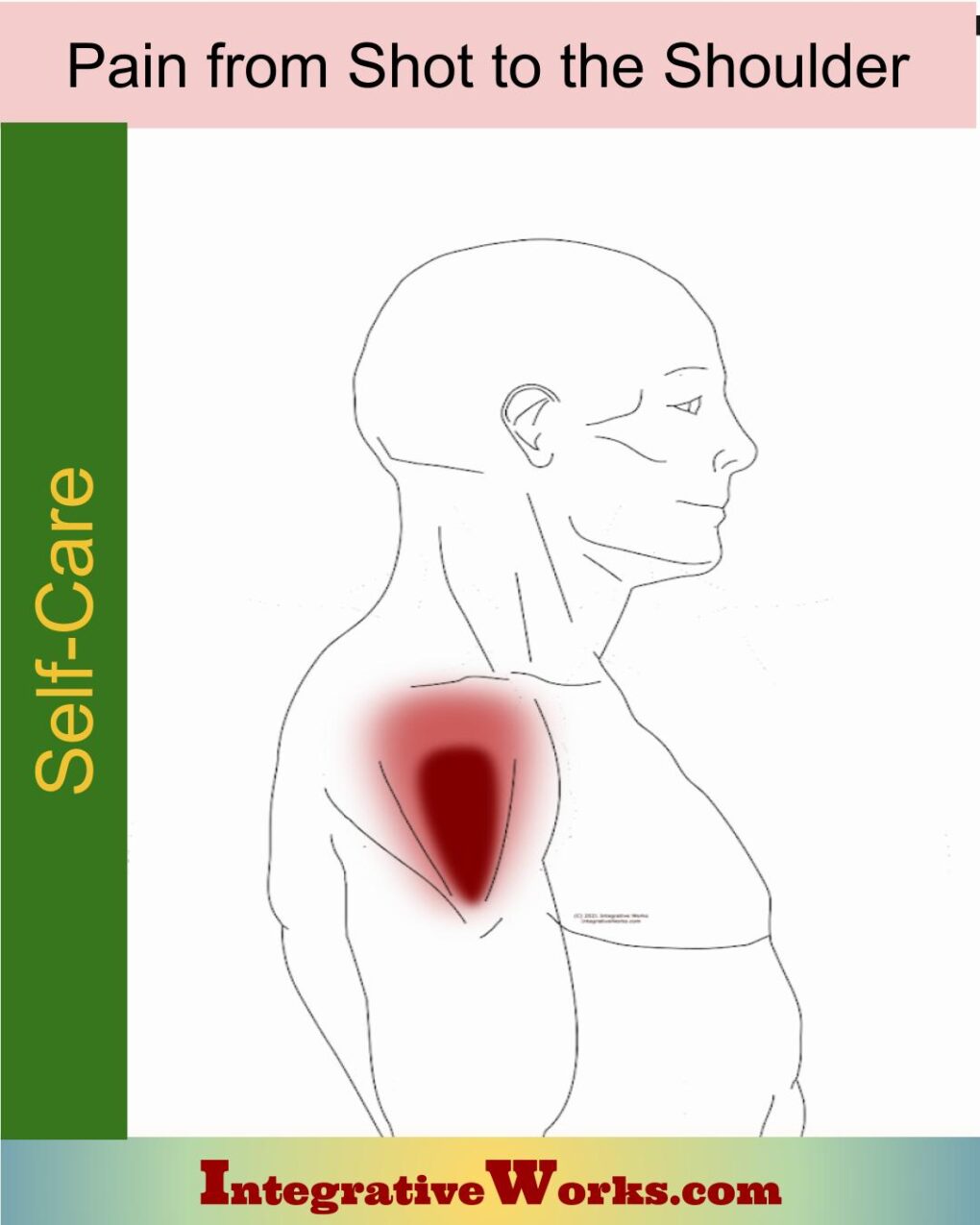Table of Contents
- How People Describe This Pain Pattern
- How You Activate and Intensify This Pain Pattern
- Self-Care – Getting Relief on Your Own
- Musculoskeletal Anatomy Behind Your Pain
- Therapy Notes for Massage and Bodywork
How People Describe This Pain Pattern

Pain Lifting Arm after Shot
A shot to the shoulder can lead people to complain of sharp pain when lifting their arm. This specific pain often hurts less at the outset of lifting the arm but increases along the outside of the shoulder. The intensity then seems to decrease again as the elbow becomes level with the shoulder.
This movement-related pain may be broad across the center of the shoulder. Or, it may focus on the lower attachment alongside the biceps and triceps.
This pattern typically appears on the side of the shoulder, even if the shot/trauma is on the front of the deltoid. This pain is created by a trigger point pattern, not nerve patterns. That means the area of pain or referral doesn’t follow the nerve patterns that you would expect. Because of that, you can release the trigger point and get relief, even though the area may continue to be a bit swollen from the vaccine. Read about how to do that in the self-care post.

An Unusual Pattern.
These patterns are not common. Most people don’t experience them except after a vaccination in the shoulder. Not that they cannot occur in other instances; see those listed below.
Even more unusual would be that the shot or trauma is to the back of the shoulder. Specifically, this happens when the trauma occurs to the fleshy part of the back of the shoulder.
There are many patterns in the back of the shoulder, and this one is the least likely. If you have pain there, it is not likely that this is your pattern. Unless you recently had a vaccination shot or sharp blow to the back of the shoulder. Take a look at this list of shoulder pain patterns.
How You Activate and Intensify This Pain Pattern

The trigger point for this pain pattern is almost always activated by trauma. Of these, the most common are:
- Vaccine or other medical injection
- Sports, like lacrosse or rugby, that involve blows to an unprotected shoulder
- Falls, motor vehicle accidents, and other situations result in blunt force to the shoulder.
Unusual though it is, I am seeing a lot more of this in my practice at the moment as patients and friends scramble for Covid-19 vaccinations.
The Musculoskeletal Anatomy Behind Your Pain
Musculoskeletal Anatomy
This post on anatomy contains standard information about the origin, insertion, function, and innervation of muscles. Additionally, it includes information on functional considerations and anomalies.
Find Related Posts
Anatomy posts have a grid of all related posts. This includes posts on pain patterns, self-care, therapy notes, NMT protocols, cranial techniques, and cases.
Getting Relief on Your Own
Clinically Proven
Self-Care Strategies
Self-Care Posts have common sections to make them easy to follow and understand:
- Activities to Avoid or Change
- Strategies for Quick Relief
- Stretches and Exercise for Longer-Lasting Relief
- Yoga Corner
Therapy Notes for Massage and Bodywork
Better Bodywork
Through Shared Expertise
Therapy Notes provide details for cranial, spinal, and local joint work. These notes also link to a traditional neuromuscular protocol.
By treating integrative components first, direct work on the muscle becomes less intense while providing longer-lasting relief.
Support Integrative Works to
stay independent
and produce great content.
You can subscribe to our community on Patreon. You will get links to free content and access to exclusive content not seen on this site. In addition, we will be posting anatomy illustrations, treatment notes, and sections from our manuals not found on this site. Thank you so much for being so supportive.
Cranio Cradle Cup
This mug has classic, colorful illustrations of the craniosacral system and vault hold #3. It makes a great gift and conversation piece.
Tony Preston has a practice in Atlanta, Georgia, where he sees clients. He has written materials and instructed classes since the mid-90s. This includes anatomy, trigger points, cranial, and neuromuscular.
Question? Comment? Typo?
integrativeworks@gmail.com
Follow us on Instagram

*This site is undergoing significant changes. We are reformatting and expanding the posts to make them easier to read. The result will also be more accessible and include more patterns with better self-care. Meanwhile, there may be formatting, content presentation, and readability inconsistencies. Until we get older posts updated, please excuse our mess.




